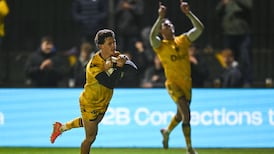Out and about on Saturday afternoon, I followed the racing on Twitter. Circumstances had combined to make it a big day – time of year, arguably Cheltenham’s best ever non-festival card, Willie Mullins sending more horses to the UK in one afternoon than he had all season. If you couldn’t be at a TV, it was unmissable online, results and commentary dripping in through various accounts, a modern-day version of following the football scores on Ceefax 303.
When Many Clouds beat Thistlecrack, the feed went into overdrive. What a horse. What a sport. Most of all, what now? Thistlecrack had been a cert for the Gold Cup but now it looked like maybe he'll be vulnerable up the Cheltenham hill come St Patrick's Day. A one-horse race was now, at least in prospect, a four- or five-horse race.
Many Clouds would have to be one of them. Grand National winners don’t go on to win the Gold Cup – in fact most of them in recent years haven’t gone on to win a race of any kind. But Many Clouds was the sort of horse that kept beating the odds, plugging on and on and ever on after the others had cried enough. In a soft-ground Gold Cup, he wouldn’t be easily dismissed.
But then, within 10 minutes, the mood on the feed cratered. Many Clouds had died of a heart attack after crossing the line. Thistlecrack and the third-place horse Smad Place went back to the winners’ enclosure but the horse that beat them never made it. Soon after, his death was announced over the PA system.
Deep sadness
Following this online, you could only feel a deep sadness. You didn’t need to have seen the race to be able to picture it. Many Clouds was the sort of horse that makes winter racing so enjoyable. The practice of ascribing human traits to horses can get a bit tiresome at times but you didn’t need to know anything about racing to recognise in him an admirable level of determination, one that wasn’t shared by most of the horses he came up against.
He wasn’t the quickest from A to B but you could rely on him to keep going all out until B was reached and passed. You can’t say that for all of them. Watching it back later, it was no surprise to see him headed between the last and the line, nor to see him rally back and nick it. You can’t not love that sort of horse.
For him to die literally trying his heart out can, in one light, be seen as an appropriate way to go. That was certainly the view taken by his trainer Oliver Sherwood on Saturday and most of the racing people whose views have been aired either in TV interviews or in the written press in the 48 hours since.
“I’ve always said that he’d die for you and he’s gone and died for us doing what he loves,” Sherwood said. “It happens to us all, we all go at some stage and he’s gone out on a high.”
Racing people take these things in their stride far more readily than outsiders. Their attitude, very simply, is that if you have livestock, you will eventually have dead stock. It’s sad when it happens but you can’t afford to be in racing and get carried away with your anguish over a dead horse. If you do, where do you go when a jockey dies or is paralysed?
Porcelain
And over time, if you’re interested in the sport, the death of a horse becomes far less jarring as you go on. You come to realise just how fragile these animals are and that their legs are especially porcelain. Moreover, the people who train them, ride them, own them and look after them are closest to them and will feel their loss the longest. Who are we to be outraged when the people who actually loved the horse accept it as part of the life?
But something about this one feels different. It’s one thing for a horse to have to be put down after breaking a leg – there is no pain-free future for the horse and it is easily understood why the humane thing to do is what it is. But Many Clouds died of a heart attack after giving the last bit of effort in its body for our entertainment. It’s difficult not to feel queasy about that.
Racing’s eternal running battle with the ban-it-all animal rights people immediately puts them on the defensive when it comes to this stuff. Anyone with questions can be easily dismissed as not understanding the sport. On the Racing UK website, one columnist described as distasteful the debate over whether Many Clouds should have still been running given that this wasn’t the first or second time his legs had wobbled after a race.
Frankly, they’re going to have to do a bit better than that. They need to be getting out there with facts and stats about equine heart attacks, educating us on how and why the horse died. Is this common? Is equine heart disease hereditary? Are there any parallels with human heart problems? Could this just as easily have happened standing in his box?
To the untrained eye, it looks like Many Clouds was run till he dropped. Is that true? And if it is, is everybody okay with that?











